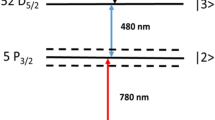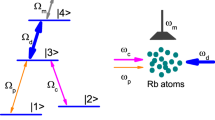Abstract
The term “quantum microwave measurement” stands for the measurement of microwave parameters by exploiting the properties of atomic energy levels and related transitions in presence of optical/laser signal. In other words, it can be stated that atoms work like a transducer, converting microwave E-Field and H-Field strengths into observable changes in optical signals. A real-time application of microwave in this domain was first investigated by Christopher and their group, where they have sensed RF electric field strength by measuring the frequency split of electromagnetically induced transparency signal in the presence RF field applied between the Rydberg states (Holloway et al. 2014a). The beauty of this experiment was that the RF E-Field strength could be made directly traceable to Planck’s constant thus reducing the uncertainties associated with other methods of measurement of E-Field using various classical probes. After that, numerous research was done by various researchers and still undergoing utilizing the optical and microwave field interaction with Rydberg atom-based systems, such as broadband RF E-Field sensing, frequency modulation, frequency up-conversion, frequency down-conversion, etc. The interaction of electromagnetic field with atomic system results in specific phenomena such as EIT and ATS (Boller et al. 1991; Marangos 1997; Anisimov et al. 2011), which also form the basis of all these applications. Therefore, in this chapter first we will discuss basic properties of Rydberg atoms, followed by the interaction of electromagnetic field with two-level atomic system. Later, EIT and ATS phenomena in a three-level system and applications will be discussed. Some of the devices based on these phenomena such as electric field sensors, microwave mixers as well as receiver for communication purposes will also be discussed in detail. As Rydberg atoms are the heart of the Quantum Microwave Measurements, different methods of fabrication of atomic vapor cells with their advantages and disadvantages will also be discussed in brief.
Similar content being viewed by others
References
Abi-Salloum TY (2010) Electromagnetically induced transparency and Autler-Townes splitting: two similar but distinct phenomena in two categories of three-level atomic systems. Phys Rev A 81(5):053836
Agarwal GS (1997) Nature of the quantum interference in electromagnetic-field-induced control of absorption. Phys Rev A 55(3):2467
Anderson DA, Paradis E, Raithel G, Sapiro RE, Holloway CL (2018, August) High-resolution antenna near-field imaging and sub-THz measurements with a small atomic vapor-cell sensing element. In: 2018 11th Glob Symp Millim Waves, GSMM 2018
Anderson DA, Sapiro RE, Raithel G (2021) An atomic receiver for AM and FM radio communication. IEEE Trans Antennas Propag 69(5):2455–2462
Anisimov P, Kocharovskaya O (2008) Decaying-dressed-state analysis of a coherently driven three-level Λ system. J Mod Opt 55(19–20):3159–3171
Anisimov PM, Dowling JP, Sanders BC (2011) Objectively discerning Autler-Townes splitting from electromagnetically induced transparency. Phys Rev Lett 107(16):163604
Autler SH, Townes CH (1955) Stark effect in rapidly varying fields. Phys Rev 100(2):703
Beterov I, Ryabtsev II, Tretyakov DB, Entin VM (2009) Quasiclassical calculations of blackbody-radiation-induced depopulation rates and effective lifetimes of Rydberg nS, nP, and nD alkali-metal atoms with n≤80. Phys Rev A 79(5):052504
Blum K (2012) Density matrix theory and applications, Springer Series on Atomic, Optical, and Plasma Physics, Vol. 64)
Boller KJ, Imamolu A, Harris SE (1991) Observation of electromagnetically induced transparency. Phys Rev Lett 66(20):2593
Comparat D, Pillet P (2010) Dipole blockade in a cold Rydberg atomic sample. J Opt Soc Am B 27(6):A208
Davuluri S, Wang Y, Zhu S (2015) Destructive and constructive interference in the coherently driven three-level systems. J Mod Opt 62(13):1091–1097
Deb B, Kjærgaard N (2018) Radio-over-fiber using an optical antenna based on Rydberg states of atoms. Appl Phys Lett 112(21):211106
Douahi A et al (2007) Vapour microcell for chip scale atomic frequency standard. Electron Lett 43(5):1
Eklund EJ, Shkel AM, Knappe S, Donley E, Kitching J (2008) Glass-blown spherical microcells for chip-scale atomic devices. Sensors Actuators, A Phys 143(1):175–180
Fleischhauer M, Imamoglu A, Marangos PJ (2005) Electromagnetically induced transparency. Rev Mod Phys 77(2):633–673
Fulton DJ, Shepherd S, Moseley RR, Sinclair BD, Dunn MH (1995) Continuous-wave electromagnetically induced transparency: A comparison of V, Λ, and cascade systems. Phys Rev A 52(3):2302
Gallagher TF (1988) Rydberg atoms. Reports Prog Phys 51(2):143
Gallagher TF, Pillet P (2008) Dipole–dipole interactions of Rydberg atoms. Adv At Mol Opt Phys 56:161–218
Giner L et al (2013) Experimental investigation of the transition between Autler-Townes splitting and electromagnetically-induced-transparency models. Phys Rev A 87(1):013823
Gordon JA, Simons MT, Haddab AH, Holloway CL (2019) Weak electric-field detection with sub-1 Hz resolution at radio frequencies using a Rydberg atom-based mixer. AIP Adv 9(4):045030
Hänsch T, Toschek P (1970) Theory of a three-level gas laser amplifier. Zeitschrift für Phys A Hadron Nucl 236(3):213–244
Heckötter J et al (2017) Scaling laws of Rydberg excitons. Phys Rev B 96(12):125142
Holloway CL et al (2014a) Broadband Rydberg atom-based electric-field probe for SI-traceable, self-calibrated measurements. IEEE Trans Antennas Propag 62(12):6169–6182
Holloway CL et al (2014b) Sub-wavelength imaging and field map** via electromagnetically induced transparency and Autler-Townes splitting in Rydberg atoms. Appl Phys Lett 104(24):244102
Holloway CL et al (2017) Atom-based RF electric field metrology: from self-calibrated measurements to subwavelength and near-field imaging. IEEE Trans Electromagn Compat 59(2):717–728
Holloway L, Simons MT, Haddab AH, Williams CJ, Holloway MW (2019) A ‘real-time’ guitar recording using Rydberg atoms and electromagnetically induced transparency: Quantum physics meets music. AIP Adv 9(6):065110
Imamoǧlu A, Harris SE (1989) Lasers without inversion: interference of dressed lifetime-broadened states. Opt Lett 14(24):1344–1346
Knapkiewicz P (2018a) Technological assessment of MEMS Alkali vapor cells for atomic references. Micromachines 2019 10(1):25
Knapkiewicz P (2018b) Alkali vapor MEMS cells technology toward high-vacuum self-pum** MEMS cell for atomic spectroscopy. Micromachines 9(8):405
Knapkiewicz P, Dziuban J, Walczak R, Mauri L, Dziuban P, Gorecki C (2010) MEMS caesium vapour cell for European micro-atomic-clock. Proc Eng 5:721–724
Kumar S, Fan H, Kübler H, Sheng J, Shaffer JP (Feb. 2017) Atom-based sensing of weak radio frequency electric fields using homodyne readout. Sci Reports 7(1):1–10
Liew LA, Knappe S, Moreland J, Robinson H, Hollberg L, Kitching J (2004) Microfabricated alkali atom vapor cells. Appl Phys Lett 84(14):2694
Liew LA, Moreland J, Gerginov V (2007) Wafer-level filling of microfabricated atomic vapor cells based on thin-film deposition and photolysis of cesium azide. Appl Phys Lett 90(11):114106
Lim J, Gyeol Lee H, Ahn J (2013) Review of cold Rydberg atoms and their applications. J Korean Phys Soc 63(4):867–876
Lombardi MA, Heavner TP, Jefferts SR (2007) NIST primary frequency standards and the realization of the SI second. NCSLI Measure 2(4):74–89
Lu X et al (2015) Transition from Autler–Townes splitting to electromagnetically induced transparency based on the dynamics of decaying dressed states. J Phys B 48(5):055003
Lukin MD et al (2000) Dipole blockade and quantum information processing in mesoscopic atomic ensembles. Phys Rev Lett 87(3):37901-1–37901-4
Marangos JP (1997) Topical review: electromagnetically induced transparency. J Mod Opt 45:471–503
Meyer DH, Cox KC, Fatemi FK, Kunz PD (2018) Digital communication with Rydberg atoms and amplitude-modulated microwave fields. Appl Phys Lett 112(21):211108
Mileti SG, Leuenbeger B, Rochat P (2010) CPT atomic clock based on rubidium 85
Petremand Y, Schori C, Straessle R, Mileti G, De Rooij N, Thomann P (2010) Low temperature indium-based sealing of microfabricated alkali cells for chip scale atomic clocks
Rand SC (2016) Lectures on light: nonlinear and quantum optics using the density matrix. Oxford Scholarship Online: August 2016, Print ISBN-13: 9780198757450
Rawat HS (2012, May) The study of Electromagnetically Induced Transparency (EIT) for its potential applications in E-field sensing Ph.D. Thesis. Academy of Scientific and Industrial Research, India
Rawat HS, Dubey SK (2020) RF E-field sensing using rydberg atom-based microwave electrometry. MAPAN 35(4):555–562
Saffman M, Walker TG, Molmer K (2009) Quantum information with Rydberg atoms. Rev Mod Phys 82(3):2313–2363
Scientists Make First Observation of Unique Rydberg Molecule. https://phys.org/news/2009-04-scientists-unique-rydberg-molecule.html. Accessed 09 Jul 2022
Sedlacek JA, Schwettmann A, Kübler H, Löw R, Pfau T, Shaffer JP (2012) Microwave electrometry with Rydberg atoms in a vapour cell using bright atomic resonances. Nat Phys 8(11):819–824
Simons MT, Haddab AH, Gordon JA, Holloway CL (2019) A Rydberg atom-based mixer: measuring the phase of a radio frequency wave. Appl Phys Lett 114(11):114101
Steck DA. Rubidium 87 D Line Data. Available online at http://steck.us/alkalidata (revision 2.2.2, 9 July 2021)
Sullivan DB (2001) Time and frequency measurement at NIST: the first 100 years. In: Proc Annu IEEE Int Freq Control Symp, pp. 4–17. https://doi.org/10.1109/FREQ.2001.956152
Tan C, Huang G (2014) Crossover from electromagnetically induced transparency to Autler-Townes splitting in open ladder systems with Doppler broadening. JOSA B 31(4):704–715
The chip-scale atomic clock-recent development progress. https://www.researchgate.net/publication/228601154_The_chip-scale_atomic_clock-recent_development_progress. Accessed 03 May 2022
Vecchio F, Venkatraman V, Shea H, Maeder T, Ryser P (2010) Dispensing and hermetic sealing Rb in a miniature reference cell for integrated atomic clocks. Proc Eng 5:367–370
Woetzel S, Talkenberg F, Scholtes T, Ijsselsteijn R, Schultze V, Meyer HG (2013) Lifetime improvement of micro-fabricated alkali vapor cells by atomic layer deposited wall coatings. Surf. Coatings Technol 221:158–162
Woetzel S, Kessler E, Diegel M, Schultze V, Meyer HG (2014) Low-temperature anodic bonding using thin films of lithium-niobate-phosphate glass. J Micromech Microeng 24(9):095001
Yang B, Chen D, Li J, Wang YP, Jia Z (2018) Cavity-enhanced microwave electric field measurement using Rydberg atoms. JOSA B 35(9):2272–2277
Author information
Authors and Affiliations
Corresponding author
Editor information
Editors and Affiliations
Section Editor information
Rights and permissions
Copyright information
© 2023 Springer Nature Singapore Pte Ltd.
About this entry
Cite this entry
Aneja, Y., Thakran, M., Sharma, A.K., Rawat, H.S., Dubey, S.K. (2023). Quantum Microwave Measurements. In: Aswal, D.K., Yadav, S., Takatsuji, T., Rachakonda, P., Kumar, H. (eds) Handbook of Metrology and Applications. Springer, Singapore. https://doi.org/10.1007/978-981-19-1550-5_79-2
Download citation
DOI: https://doi.org/10.1007/978-981-19-1550-5_79-2
Received:
Accepted:
Published:
Publisher Name: Springer, Singapore
Print ISBN: 978-981-19-1550-5
Online ISBN: 978-981-19-1550-5
eBook Packages: Springer Reference EngineeringReference Module Computer Science and Engineering
Publish with us
Chapter history
-
Latest
Quantum Microwave Measurements- Published:
- 06 June 2023
DOI: https://doi.org/10.1007/978-981-19-1550-5_79-2
-
Original
Quantum Microwave Measurements- Published:
- 29 March 2023
DOI: https://doi.org/10.1007/978-981-19-1550-5_79-1




